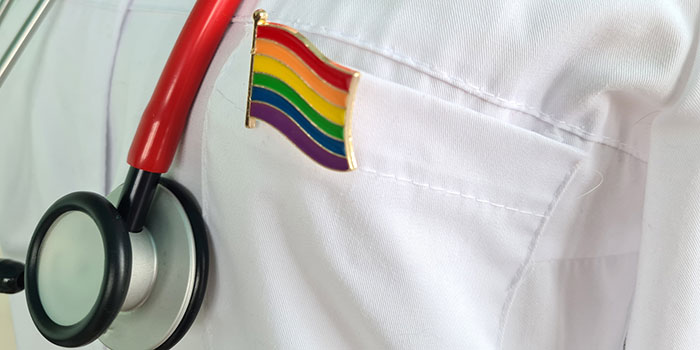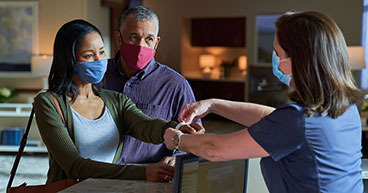
Cancer has no gender or sexual orientation. It doesn’t discriminate against lesbian, gay, bisexual, transgender, questioning or straight individuals. There’s no such thing as “transgender cancer” or “gay cancer.”
But some members of the LGBTQIA+ community face higher cancer risks and hurdles to diagnosis, treatment and health care access, according to medical research. They’re more likely to confront discrimination in medical settings, which may compromise and delay screening and treatment while increasing stress and anxiety, studies show.
Hormone-replacement therapy (HRT), commonly used in gender-affirming care for transgender individuals, may also increase cancer risks for some patients, although more research is needed to confirm, quantify and balance the risks against the benefits.
Compounding the problem are significant gaps in health research data on cancer in the LGBTQIA+ population—because medical records don’t typically collect gender identity information—posing additional challenges to risk assessment, diagnosis and care.
To help you understand the risks, screening options and treatments available to LGBTQIA+ patients, this article explains and explores the following topics:
- Cancer risks among gay, lesbian or transgender patients
- Hormones and cancer risk: What the research says
- Cancer screening for transgender patients
- Factors that may raise cancer risk in the LGBTQIA+ community
- The importance of finding an LGBTQIA-friendly doctor
- Cancer survival rates for transgender patients
If you’ve been diagnosed with cancer and are interested in a second opinion on your diagnosis and treatment plan, call us or chat online with a member of our team.
Cancer risks among LGBTQIA+ patients
The number of Americans who identify as lesbian, gay, bisexual, transgender, queer or questioning has doubled over the past 10 years, a recent Gallup poll found. Despite that increase, research shows these individuals continue to face health care barriers, including disparities in cancer risk and treatment.
“Unfortunately, there are still many gaps in the cancer care continuum, starting with prevention and early detection,” Diego Rodriguez, MSN, RN, OCN, Senior Regional Nursing Director at City of Hope Duarte told Oncology Nursing News. “LGBTQIA+ patients may skip regular cancer screenings because they don’t feel welcome at certain medical facilities, especially where staff haven’t received LGBTQIA+ cultural competency training. This can lead to patients being diagnosed with cancer at a more advanced stage, limiting their treatment options.”
But other factors may also put transgender patients and other members of the LGBTQIA+ community at increased risk for cancer, according to a growing body of medical research. Among the factors:
- Bias and discrimination in medical settings pose significant hurdles to cancer screening, risk assessments and care for some LGBTQIA+ individuals that may lead them to delay or avoid seeking critical care.
- Emotional trauma, stress, anxiety and other physiological factors may increase levels of inflammation and stress hormones such as cortisol. Chronic inflammation and higher cortisol levels may raise cancer risk.
- Other potential risk factors that are more common in the LGBTQIA+ community include hormone-replacement therapy in gender-affirming care and cancer treatments.
- Certain members of the LGBTQIA+ are more likely to use tobacco and/or alcohol, be overweight and practice other lifestyle habits that may put them at higher risk for cancer than others.
- Lack of insurance is another barrier to health care access that may delay diagnosis and treatment. For instance, transgender people are often diagnosed at more advanced stages of cancer development and have lower survival rates for several cancer types, compared to other patients.
Hormones and cancer risk: What the research says
One particularly complex issue for those in the LGBTQIA+ community, especially transgender individuals, is gender-affirming hormone-replacement therapy. This is a type of HRT that allows individuals to acquire gender characteristics more aligned with their identity.
Research findings have been mixed on the potential cancer risk posed by gender-affirming HRT for transgender people, as well as breast cancer patients and those who use HRT to treat post-menopausal symptoms. The mixed findings have led to what the authors of one recent study called “troubling blind spots” in understanding cancer risks that “may be impeding cancer screening and risk assessments for the transgender population.”
Few studies have examined the long-term effects of gender-affirming hormone therapy and cancer risk, and transgender health advocates say the risks are almost never weighed against the potential benefits. As a result, large gaps and conflicting evidence in peer-reviewed studies have led some doctors to warn patients away from HRT therapy, emphasizing the potential risk.
The research gap is another factor—in addition to discrimination, inadequate or biased provider communication and barriers to health care access—that has complicated evaluations of transgender cancer risk and transgender cancer treatment, LGBTQIA+ health advocates say.
Cisgender people, those whose gender identity matches the sex they were assigned at birth, may also require hormone replacement therapy. Doctors prescribe it to treat menopausal symptoms and prevent bone loss and fractures, even though large clinical trials have suggested that HRT may increase the risk of cancer and other serious conditions. In those instances, patients and their providers have often determined that the benefits outweigh the risks.
Some transgender health advocates say physicians of transgender patients don’t routinely engage in similarly balanced discussions of risks and benefits and overemphasize the cancer links.
Two recent reviews of past studies found no significant increase in tumor risk among transgender individuals receiving gender-affirming hormone therapy, although the authors of both reviews acknowledged the need for better studies and risk assessments.
Another study in the Netherlands that included 2,260 transgender women and 1,229 transgender men receiving gender-affirming hormones concluded that:
- Breast cancer risk for transgender women who received mostly antiandrogen and estrogen therapy was about 47 times higher than the risk for Dutch cisgender men. The risk was more than three times lower than the risk for Dutch cisgender women.
- Breast cancer risk for transgender men receiving testosterone therapy was much higher than that for cisgender men but approximately five times lower than the risk for cisgender women.
The takeaway: Health experts say doctors need to explain both the potential cancer risks of hormone therapy for trans people as well as the risks of not taking HRT, which include a potential increase in suicidal ideation. A 2018 study of 206 transgender veterans, for example, found that access to gender-affirming hormone therapy, as well as surgical transition interventions, significantly reduced their frequency of suicidal ideation and depressive symptoms.
Cancer screening for transgender patients
Screening for cancer, to identify it before symptoms appear, is one of the best ways to identify tumors and abnormal cells early, when more treatment options tend to be available. The American Cancer Society has compiled a useful online resource—Cancer Screening Guidelines by Age—that breaks down standard recommendations by age and gender for various types of cancer.
But these one-size-fits-all guidelines may not adequately apply to transgender individuals or others in the LGBTQIA+ community. For instance, screening recommendations for testicular cancer may not be relevant to a presurgical patient who identifies as female. Similarly, guidelines for breast and cervical cancer screening may not make sense for a transgender cancer patient who identifies as male and is considering transitional surgery. Those receiving feminizing or masculinizing HRT treatments may also need more individualized patient-centered screening plans.
That’s why it’s critically important for patients and their doctors to work together to develop personalized cancer screening plans that take all factors into account, including particular cancer risks among lesbian, gay, bisexual, transgender, queer or questioning individuals.
Factors that may raise cancer risk in the LGBTQIA+ community
According to research compiled by the National LGBT Cancer Network:
Lesbian and bisexual women are more likely than heterosexual women to have poor physical and mental health, asthma or diabetes, and they were more likely to be overweight, smoke and drink excessive amounts of alcohol. Those factors could put them at greater risk for breast cancer, as well as other cancers that have been linked to smoking, obesity and alcohol abuse.
Among gay men, cigarette smoking is nearly double that of the general population, increasing the risk of lung cancer, colon cancer, esophageal cancer and anal cancer.
The same high-risk strains of human papilloma virus (HPV) that cause most cervical cancers in women are also linked to anal cancer and may be spread through anal sex. An estimated 65 percent of gay men without HIV have the virus, while an estimated 95 percent of those who are HIV positive have it.
Bisexual men and women have reported more barriers to health care, current sadness, past-year suicidal ideation and limited or no health insurance than gay, lesbian or straight individuals. One American study of women aged 50-79 found bisexual women reported higher rates of any type of cancer than their heterosexual or lesbian counterparts. Bisexual women are less likely to give birth, putting them at greater risk of breast, ovarian and endometrial cancers.
Transgender and gender-nonconforming people face significant barriers to quality health care, frequent discrimination by health care providers (many of whom also lack information about trans bodies) and are more likely to lack insurance than others in the LGBTQIA+ community. In New York City, for example, the Department of Health found 21 percent of transgender respondents reported having no health insurance of any kind, and even those with coverage faced difficulties in obtaining appropriate cancer screenings.
A transgender woman, listed on her insurance as female but still having an intact prostate gland, would not be covered for prostate cancer screening. The same is true for a transgender man with an intact cervix. Transgender people also have higher rates of smoking, drinking and HIV, increasing their risks for developing an array of cancers, including lung cancer, anal cancer and liver cancer.
The importance of finding an LGBTQIA-friendly doctor
One consideration for patients: Coming out to their doctor about their gender identity and sexuality may be an important step to developing an effective screening plan and reducing barriers to diagnosis and treatment.
According to the National LGBT Cancer Project, gay, bisexual and transgender individuals may increase the possibility of better health outcomes by taking that first step of choosing a health care provider who is open to all their health concerns. This is particularly true for those at risk for anal, oral, vaginal, cervical or penile cancers, which are linked to HPV, which is transmitted through sexual activity and intimate skin-to-skin contact.
Having a doctor who understands your specific health care needs, including sexual health, may go a long way toward an early diagnosis or an effective treatment plan for cancer, experts say.
Early detection and diagnosis are important in all forms of cancer—and for all individuals, regardless of gender identity and sexuality—because patients with earlier-stage cancers tend to have more available treatment options. Finding a specialized doctor who is LGBTQIA+ friendly increases the likelihood that you can have comfortable and frank patient-doctor interactions that may lower your cancer risk and boost the quality of your care.

Cancer survival rates for transgender patients
The National LGBT Cancer Project estimates more than 1 million LGBTQIA+ cancer survivors are living in the United States today. But studies show members of the LGBTQIA+ community bear a disproportionate cancer burden and have lower survival rates.
But it’s not because lesbian, gay, bisexual, transgender and questioning people have a unique cluster of risk factors, researchers say. The reason has more to do with health disparities, health care access and delays in treatment.
“Transgender people may be diagnosed at later stages, be less likely to receive treatment, and have worse survival for several cancer types, compared to cisgender patients,” according to a 2021 study published in the Journal of the National Cancer Institute.
A research team led by Sarah Jackson, PhD, a postdoctoral fellow in the NCI’s Infections and Immunoepidemiology Branch, examined the National Cancer Database and found that transgender patients with non-Hodgkin lymphoma, prostate cancer or bladder cancer were twice as likely to die than cisgender patients.
They were also up to twice as likely to be diagnosed at more advanced stages for lung cancer and 70 percent to 80 percent less likely to receive treatment if they had kidney or pancreatic cancer.
“The National Transgender Discrimination Survey from 2015 showed that transgender individuals, whose gender identity differs from their sex assigned at birth, experience many barriers to healthcare access, including lack of insurance and discrimination in medical settings,” the researchers concluded. “These barriers may delay diagnosis and treatment of cancer and result in decreased survival of transgender patients, however data on cancer in this population are limited since most medical records do not collect gender identity.”
Jackson said the results highlight the need to improve the collection of gender identity data separate from the gender assigned at birth to facilitate research on this underserved community.
City of Hope: Designated a 'Healthcare Equality Leader'
At City of Hope, we recognize the unique needs of our LGBTQIA+ patients. We don’t make assumptions about our patients and their loved ones. Instead, we work closely with them to devise personalized screening, diagnostic and treatment plans.
“The LGBTQIA+ community comprises diverse groups of individuals with distinct health care needs,” Rodriguez says. “Making assumptions about patients can be dangerous and lead to lapses in care.”
In 2023, City of Hope was among 496 health care facilities awarded a LGBTQIA+ Healthcare Equality Leader designation from the Human Rights Campaign Foundation—the fourth year the hospital system has received the honor. The Healthcare Equality Index is the national LGBTQIA+ benchmarking tool that evaluates health care facilities’ policies and practices related to employees, visitors and LGBTQIA+ patients.
If you’ve been diagnosed with cancer and are interested in a second opinion on your diagnosis and treatment plan, call us or chat online with a member of our team.



